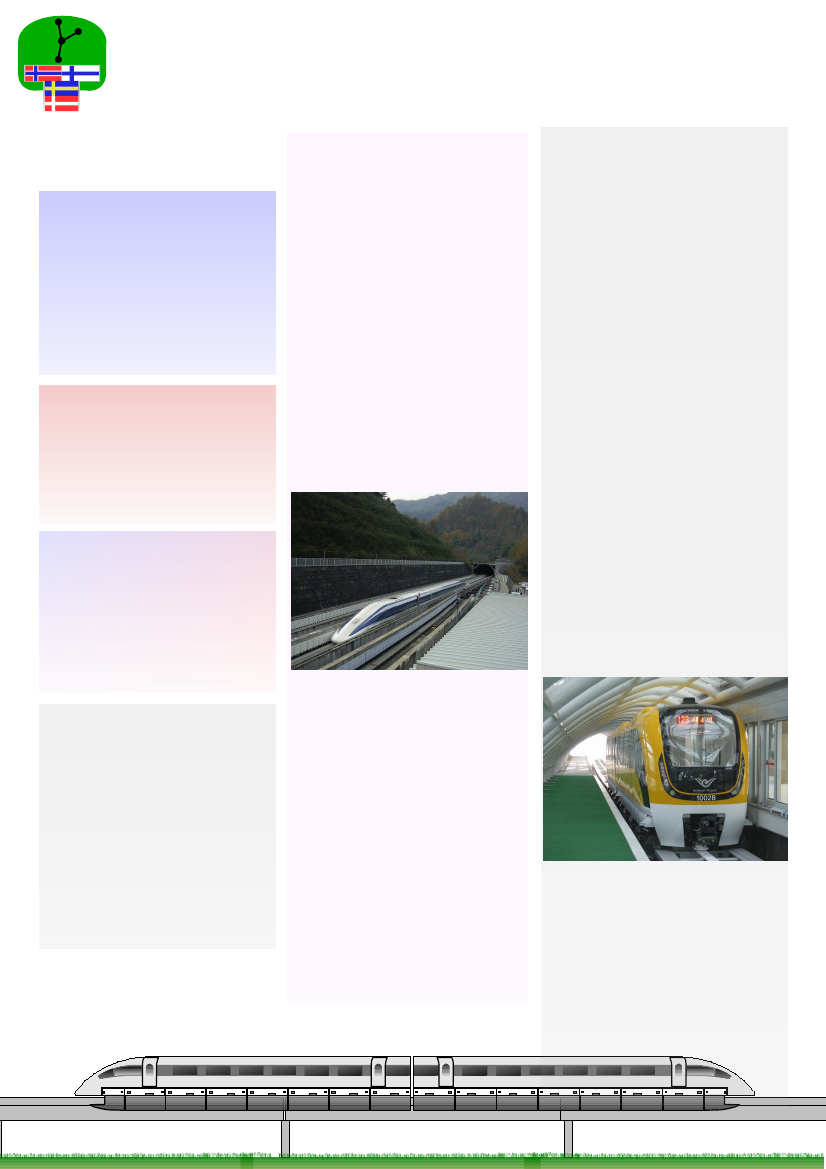
Newsletter 2014 - 5
News
Sweden
After the Swedish election planing
for ”Ostlänken” is pushed forward
and planed starting date is around
2017. At the same time the road-
told for central Göteborg was voted
down in the election. This will
jeopardize ”Västlänken” that
suppose to be partly financed by
the road-told. New solutions are
now explored.
Magnetic-train Scandinavia
Yamanashi Maglev
Test Line
Series – Magnetic trains around the globe
2014-10-29
Welcome to the only inter-Nordic
newsletter about magnetic-trains.
Västlänken
replacement
Part 5: Local maglev systems
Why don´t Göteborg have a subway
system? Because they have nothing
to hide!
But there might be one needed in the
future. The city is growing and put a
high strain on both the tram-system
and commuter trains. A solution is
proposed to go with computer train
right throw the city in heavy rail
tunnels. But the cost effectiveness of
the solution have been put into
question.
Have you ever travelled by subway
train, in any city, and wondered why
its so dirty on the tracks? All trains
are electric, so where do all the dust
come from. Well its mechanical dust,
breaking dust, dust from power-
pickup, wheel dust. This exist on
trams and trains over ground to, but
there it get washed away by rain to
some extent.
So is there any way of getting rid of
dust, noise and expensive tunnels yet
build a good commuter network. Yes
there is, local maglev trains.
Maglev trains come in many shapes
and forms, and the intermediate
speed, around 100-120km/h are the
most common.
Denmark
The problems with IC4 trains is now
disused at the highest government
level in Denmark. If no solution can
be found there is a real risk that all
IC4 trains have to be scraped for a
huge monetary loss.
Link
Magnetic levitation trains were first
exterminated I Japan during the
early 1970's. A 7 km long test-track
to evaluate different systems was
constructed in 1977. The
configuration has changed several
times during the lifespan of the
test-track.
When the Japanese railway
system was privatized in 1989 the
test-track was handed over to JR-
Central. It was quickly released
that a new test-track for full scale
maglev system was needed, so a
new track was started in 1990.
In 1997 the Yamanashi Maglev
Test Line was finished just over
18km of double track mostly within
tunnels
Norway
The earlier strategy of running the “8
million city”-trains at the at 330km/h
is now under question because of
high running costs. A proposed
solution to the problem is lowering
the top speed to 250km/h, but then
maglev technology is a better option
Link
Picture: Yamanashi test track with a
MLX01 experimental train
International
After years of planing Japan Rail
have applied for final construction
start approval.
Link
Japan rail invite citizens of Japan to
try out the new L0 maglev train for
them self before the test track is
closed down for redeployment as
part of the new maglev shinkansen.
Link
USA: Orlando maglev is going a
head as planed.
Link
Combined with the MLX01
experimental train, the system
broke several land speed records.
In 1999 the track open for
commercial tourist traffic.
The line was used in a combined
test and tourist function until 2011
when it was closed down for
expansion. In 2014 it reopened for
test use only with the new
commercial L0 train pre-production
prototype and the total line length
was almost 43 km, all double track.
In 2015 the test-track is planed to
be permanently closed as a test-
track and reopened first 2026 as
part of the new Chūō Shinkansen
connecting Tokyo and Nagoya as a
high capacity commercial line.
Picture: Off the shelf Hyundai Rotem
maglev train.
Cost effective, quite, dust-free and
quick urban transport.
An over ground urban maglev system
is fast and easy to build and don’t
create any barrier effect. It can travel
roads and bike paths with no
disturbance and is almost completely
silent.